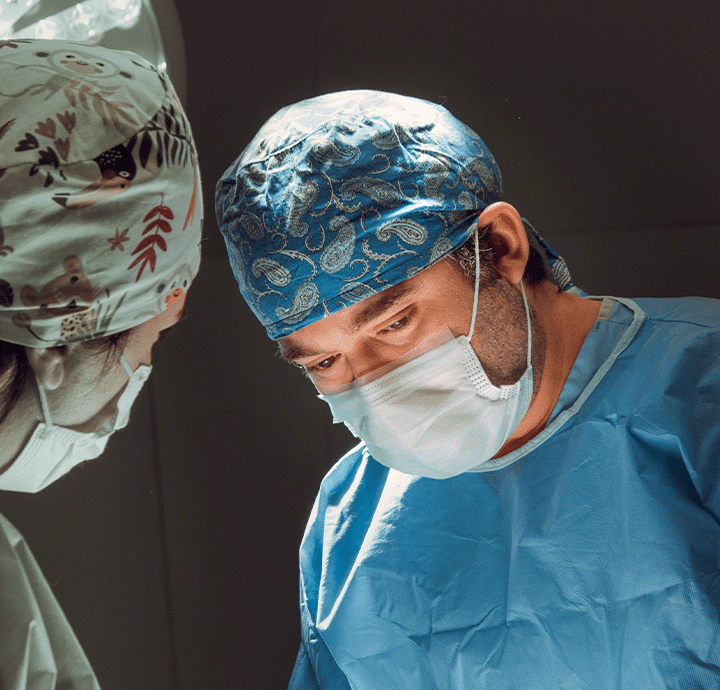
Edema formation is an expected condition after rhinoplasty surgery and is encountered in almost all patients. Intense bruising and swelling are observed, especially around the eyes, within a week after the operation. These bruises and swelling, which increase on the second and third days, usually disappear spontaneously within a week. The healing and swelling process after rhinoplasty varies from person to person. Since the subcutaneous tissues are intervened during the operation, edema is seen during the healing of these tissues and the upper skin. In fact, edema is part of the recovery process. The edema, which decreases from the first week, disappears completely within approximately 6 months to 1 year. More and prolonged edema occurs in patients with thicker skin. However, whatever happens, these are temporary and usual complications. Therefore, patients must have patience, especially about the edema, during the recovery process.
Your doctor will help you to reduce the edema that occurs after rhinoplasty surgery faster. During the healing process, cold compresses are frequently used to relieve edema. Cold compress application will also shrink the thin vessels that will cause bleeding and prevent all bruises that may be seen later. Cold compress is not only beneficial agaat edema but also has a pain-relieving effect.
After leaving the hospital, patients can also eliminate edema, swelling, and bruising with the application of ice packs at home. While doing this, be sure to put a cloth or towel between the ice pack and the skin. Otherwise, you may injure your nose. In addition, eating less salty foods will also reduce the effect of edema. For this reason, you should avoid salty meals and especially junk foods such as chips in the first weeks. It is a classic but very effective method to sleep with your head elevated to prevent the increase in edema, so try sleeping with a double pillow.
In short, it is inevitable to encounter bruising and swelling even though it is undesirable, especially after rhinoplasty operations performed using the open technique. This situation, which is extremely normal and expected, can disappear faster with a few methods applied by the patient and the doctor. These are temporary complications that tend to go away spontaneously within a week or two. You can also do the massage recommended by your doctor to reduce edema.
How to Reduce Swelling after Rhinoplasty?
Rhinoplasty, also known as a nose job, is one of the most popular cosmetic surgeries worldwide. While the results can be life-changing, the recovery process requires patience and care. One of the most common concerns patients face is post-rhinoplasty swelling. Although swelling is a normal part of healing, many people want to know how to minimize it and speed up recovery.
Why Does Swelling Occur After Rhinoplasty?
Swelling after rhinoplasty happens because the delicate tissues of the nose are manipulated during surgery. The body naturally responds to this trauma with inflammation, which is part of the healing process. In the first few days, swelling can be more noticeable, especially around the nose and under the eyes. Over time, most of the swelling subsides, but it may take several months for the nose to fully settle into its new shape.
Effective Tips to Reduce Swelling After Rhinoplasty

1. Keep Your Head Elevated
One of the simplest yet most effective ways to reduce swelling after rhinoplasty is to sleep with your head elevated. Use two or three pillows or a wedge pillow to keep your head above your chest.
2. Apply Cold Compresses
Applying a cold compress around (not directly on) the nose during the first 48 hours helps reduce inflammation and discomfort. Be careful not to put pressure on the nasal bridge.
3. Follow a Low-Sodium Diet
A low-sodium diet helps prevent water retention. Fresh fruits, vegetables, and lean proteins will support recovery, while staying hydrated aids in flushing out toxins.
4. Avoid Strenuous Activities
Activities that raise blood pressure—such as heavy lifting or intense workouts—can worsen swelling. Gentle walking, however, can boost circulation and promote healing.
5. Take Prescribed Medications
Follow your surgeon’s instructions regarding medications. Avoid taking aspirin or ibuprofen unless approved, as they may increase bleeding risk.
6. Be Patient
Swelling after rhinoplasty gradually decreases, but full results can take up to a year. Trusting the healing process is essential.
What to Avoid During Recovery
Smoking and alcohol consumption
Hot showers, steam rooms, and excessive sun exposure
Wearing glasses or sunglasses that rest on the nose bridge
When to Contact Your Surgeon
While mild swelling is expected, seek medical advice if you notice:
Excessive pain
Sudden increase in swelling
Breathing difficulties
Unusual discharge
Final Thoughts
Learning how to reduce swelling after rhinoplasty is key to a smooth recovery. By keeping your head elevated, eating a balanced diet, and carefully following your surgeon’s advice, you can enjoy a faster healing process and long-lasting results. Remember, patience is the most important factor—the final outcome is worth the wait.

